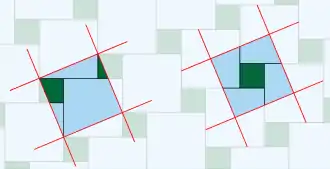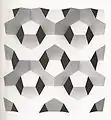Pythagorean tiling
A Pythagorean tiling or two squares tessellation is a tiling of a Euclidean plane by squares of two different sizes, in which each square touches four squares of the other size on its four sides. Many proofs of the Pythagorean theorem are based on it,[2] explaining its name.[1] It is commonly used as a pattern for floor tiles. When used for this, it is also known as a hopscotch pattern[3] or pinwheel pattern,[4] but it should not be confused with the mathematical pinwheel tiling, an unrelated pattern.[5]

.jpg.webp)
This tiling has four-way rotational symmetry around each of its squares. When the ratio of the side lengths of the two squares is an irrational number such as the golden ratio, its cross-sections form aperiodic sequences with a similar recursive structure to the Fibonacci word. Generalizations of this tiling to three dimensions have also been studied.
Topology and symmetry
The Pythagorean tiling is the unique tiling by squares of two different sizes that is both unilateral (no two squares have a common side) and equitransitive (each two squares of the same size can be mapped into each other by a symmetry of the tiling).[6]
Topologically, the Pythagorean tiling has the same structure as the truncated square tiling by squares and regular octagons.[7] The smaller squares in the Pythagorean tiling are adjacent to four larger tiles, as are the squares in the truncated square tiling, while the larger squares in the Pythagorean tiling are adjacent to eight neighbors that alternate between large and small, just as the octagons in the truncated square tiling. However, the two tilings have different sets of symmetries, because the truncated square tiling is symmetric under mirror reflections whereas the Pythagorean tiling isn't. Mathematically, this can be explained by saying that the truncated square tiling has dihedral symmetry around the center of each tile, while the Pythagorean tiling has a smaller cyclic set of symmetries around the corresponding points, giving it p4 symmetry.[8] It is a chiral pattern, meaning that it is impossible to superpose it on top of its mirror image using only translations and rotations.
A uniform tiling is a tiling in which each tile is a regular polygon and in which every vertex can be mapped to every other vertex by a symmetry of the tiling. Usually, uniform tilings additionally are required to have tiles that meet edge-to-edge, but if this requirement is relaxed then there are eight additional uniform tilings. Four are formed from infinite strips of squares or equilateral triangles, and three are formed from equilateral triangles and regular hexagons. The remaining one is the Pythagorean tiling.[9]
Pythagorean theorem and dissections

This tiling is called the Pythagorean tiling because it has been used as the basis of proofs of the Pythagorean theorem by the ninth-century Islamic mathematicians Al-Nayrizi and Thābit ibn Qurra, and by the 19th-century British amateur mathematician Henry Perigal.[1][10][11][12] If the sides of the two squares forming the tiling are the numbers a and b, then the closest distance between corresponding points on congruent squares is c, where c is the length of the hypotenuse of a right triangle having sides a and b.[13] For instance, in the illustration to the left, the two squares in the Pythagorean tiling have side lengths 5 and 12 units long, and the side length of the tiles in the overlaying square tiling is 13, based on the Pythagorean triple (5,12,13).
By overlaying a square grid of side length c onto the Pythagorean tiling, it may be used to generate a five-piece dissection of two unequal squares of sides a and b into a single square of side c, showing that the two smaller squares have the same area as the larger one. Similarly, overlaying two Pythagorean tilings may be used to generate a six-piece dissection of two unequal squares into a different two unequal squares.[10]
Aperiodic cross sections

Although the Pythagorean tiling is itself periodic (it has a square lattice of translational symmetries) its cross sections can be used to generate one-dimensional aperiodic sequences.[14]
In the "Klotz construction" for aperiodic sequences (Klotz is a German word for a block), one forms a Pythagorean tiling with two squares whose sizes are chosen to make the ratio between the two side lengths be an irrational number x. Then, one chooses a line parallel to the sides of the squares, and forms a sequence of binary values from the sizes of the squares crossed by the line: a 0 corresponds to a crossing of a large square and a 1 corresponds to a crossing of a small square. In this sequence, the relative proportion of 0s and 1s will be in the ratio x:1. This proportion cannot be achieved by a periodic sequence of 0s and 1s, because it is irrational, so the sequence is aperiodic.[14]
If x is chosen as the golden ratio, the sequence of 0s and 1s generated in this way has the same recursive structure as the Fibonacci word: it can be split into substrings of the form "01" and "0" (that is, there are no two consecutive ones) and if these two substrings are consistently replaced by the shorter strings "0" and "1" then another string with the same structure results.[14]
Related results
According to Keller's conjecture, any tiling of the plane by congruent squares must include two squares that meet edge-to-edge.[15] None of the squares in the Pythagorean tiling meet edge-to-edge,[6] but this fact does not violate Keller's conjecture because the tiles have different sizes, so they are not all congruent to each other.
The Pythagorean tiling may be generalized to a three-dimensional tiling of Euclidean space by cubes of two different sizes, which also is unilateral and equitransitive. Attila Bölcskei calls this three-dimensional tiling the Rogers filling. He conjectures that, in any dimension greater than three, there is again a unique unilateral and equitransitive way of tiling space by hypercubes of two different sizes.[16]
Burns and Rigby found several prototiles, including the Koch snowflake, that may be used to tile the plane only by using copies of the prototile in two or more different sizes.[17] An earlier paper by Danzer, Grünbaum, and Shephard provides another example, a convex pentagon that tiles the plane only when combined in two sizes.[18] Although the Pythagorean tiling uses two different sizes of squares, the square does not have the same property as these prototiles of only tiling by similarity, because it also is possible to tile the plane using only squares of a single size.
Application
An early structural application of the Pythagorean tiling appears in the works of Leonardo da Vinci, who considered it among several other potential patterns for floor joists.[19] This tiling has also long been used decoratively, for floor tiles or other similar patterns, as can be seen for instance in Jacob Ochtervelt's painting Street Musicians at the Door (1665).[1] It has been suggested that seeing a similar tiling in the palace of Polycrates may have provided Pythagoras with the original inspiration for his theorem.[13]
References
- Nelsen, Roger B. (November 2003), "Paintings, plane tilings, and proofs" (PDF), Math Horizons, 11 (2): 5–8, doi:10.1080/10724117.2003.12021741, S2CID 126000048. Reprinted in Haunsperger, Deanna; Kennedy, Stephen (2007), The Edge of the Universe: Celebrating Ten Years of Math Horizons, Spectrum Series, Mathematical Association of America, pp. 295–298, ISBN 978-0-88385-555-3. See also Alsina, Claudi; Nelsen, Roger B. (2010), Charming proofs: a journey into elegant mathematics, Dolciani mathematical expositions, vol. 42, Mathematical Association of America, pp. 168–169, ISBN 978-0-88385-348-1.
- Wells, David (1991), "two squares tessellation", The Penguin Dictionary of Curious and Interesting Geometry, New York: Penguin Books, pp. 260–261, ISBN 0-14-011813-6.
- "How to Install Hopscotch Pattern Tiles", Home Guides, San Francisco Chronicle, retrieved 2016-12-12.
- Editors of Fine Homebuilding (2013), Bathroom Remodeling, Taunton Press, p. 45, ISBN 978-1-62710-078-6. A schematic diagram illustrating this floor tile pattern appears earlier, on p. 42.
- Radin, C. (1994), "The Pinwheel Tilings of the Plane", Annals of Mathematics, 139 (3): 661–702, doi:10.2307/2118575, JSTOR 2118575
- Martini, Horst; Makai, Endre; Soltan, Valeriu (1998), "Unilateral tilings of the plane with squares of three sizes", Beiträge zur Algebra und Geometrie, 39 (2): 481–495, MR 1642720.
- Grünbaum, Branko; Shephard, G. C. (1987), Tilings and Patterns, W. H. Freeman, p. 171.
- Grünbaum & Shephard (1987), p. 42.
- Grünbaum & Shephard (1987), pp. 73–74.
- Frederickson, Greg N. (1997), Dissections: Plane & Fancy, Cambridge University Press, pp. 30–31.
- Aguiló, Francesc; Fiol, Miquel Angel; Fiol, Maria Lluïsa (2000), "Periodic tilings as a dissection method", American Mathematical Monthly, 107 (4): 341–352, doi:10.2307/2589179, JSTOR 2589179, MR 1763064.
- Grünbaum & Shephard (1987), p. 94.
- Ostermann, Alexander; Wanner, Gerhard (2012), "Thales and Pythagoras", Geometry by Its History, Undergraduate Texts in Mathematics, Springer, pp. 3–26, doi:10.1007/978-3-642-29163-0_1. See in particular pp. 15–16.
- Steurer, Walter; Deloudi, Sofia (2009), "3.5.3.7 The Klotz construction", Crystallography of Quasicrystals: Concepts, Methods and Structures, Springer Series in Materials Science, vol. 126, Springer, pp. 91–92, doi:10.1007/978-3-642-01899-2, ISBN 978-3-642-01898-5.
- The truth of his conjecture for two-dimensional tilings was known already to Keller, but it was since proven false for dimensions eight and above. For a recent survey on results related to this conjecture, see Zong, Chuanming (2005), "What is known about unit cubes", Bulletin of the American Mathematical Society, New Series, 42 (2): 181–211, doi:10.1090/S0273-0979-05-01050-5, MR 2133310.
- Bölcskei, Attila (2001), "Filling space with cubes of two sizes", Publicationes Mathematicae Debrecen, 59 (3–4): 317–326, doi:10.5486/PMD.2001.2480, MR 1874434, S2CID 226270246. See also Dawson (1984), which includes an illustration of the three-dimensional tiling, credited to "Rogers" but cited to a 1960 paper by Richard K. Guy: Dawson, R. J. M. (1984), "On filling space with different integer cubes", Journal of Combinatorial Theory, Series A, 36 (2): 221–229, doi:10.1016/0097-3165(84)90007-4, MR 0734979.
- Burns, Aidan (1994), "78.13 Fractal tilings", Mathematical Gazette, 78 (482): 193–196, doi:10.2307/3618577, JSTOR 3618577, S2CID 126185324. Rigby, John (1995), "79.51 Tiling the plane with similar polygons of two sizes", Mathematical Gazette, 79 (486): 560–561, doi:10.2307/3618091, JSTOR 3618091, S2CID 125458495.
- Figure 3 of Danzer, Ludwig; Grünbaum, Branko; Shephard, G. C. (1982), "Unsolved Problems: Can All Tiles of a Tiling Have Five-Fold Symmetry?", The American Mathematical Monthly, 89 (8): 568–570+583–585, doi:10.2307/2320829, JSTOR 2320829, MR 1540019.
- Sánchez, José; Escrig, Félix (December 2011), "Frames designed by Leonardo with short pieces: An analytical approach", International Journal of Space Structures, 26 (4): 289–302, doi:10.1260/0266-3511.26.4.289, S2CID 108639647.

